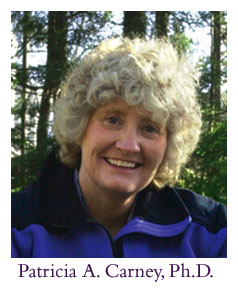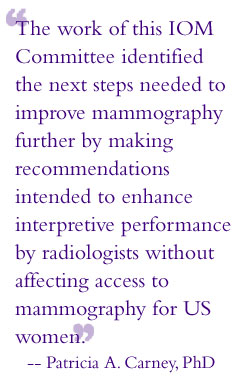|
|
For Release: May 23, 2005
Contact: Andy Nordhoff (603) 650-1492
Performance Audit Needed to Ensure and Improve Accuracy of Mammograms
WASHINGTON - To help breast imaging facilities determine how accurately they are interpreting mammograms, the FDA should require the facilities to collect additional data that can be used to better measure their staffs' performance, says a new report from the Institute of Medicine of the National Academies. Among the recommendations from the committee who wrote the report is the reimbursement rate for mammography should be boosted to cover additional staff time and other expenses needed for the enhanced audit.

"The original work of the Mammography Quality Standards Act (MQSA) was very successful in improving the technical image quality of mammography," said Dr. Patricia Carney, associate professor of community and family medicine at Dartmouth Medical School and chairperson of the working group that developed Chapter 2 of the report and recommendations 1-4 on enhancing image interpretation. She is also director of the cancer control program at Dartmouth's Norris Cotton Cancer Center and director of the New Hampshire Mammography Network. "The work of this IOM Committee identified the next steps needed to improve mammography further by making recommendations intended to enhance interpretive performance by radiologists without affecting access to mammography for US women."
Although the technical quality of mammography has improved significantly since MQSA was passed in 1992, questions remain about the quality of mammogram interpretation, which is subjective and difficult to measure. To prepare for the anticipated reauthorization of MQSA in 2007, Congress asked the Institute of Medicine to examine whether additional steps could be taken to improve the accuracy of mammography interpretation or to enhance regulatory oversight. Although the technical quality of mammography has accurate interpretation is important because missed cancers can reduce mammography's potential to save lives. On the other hand, "false positive" readings lead to unnecessary biopsies that entail pain and emotional stress for patients, as well as additional costs.
"The effectiveness of mammography greatly depends on how well staff interpret breast images," said committee chair John Ball, executive vice president, American Society for Clinical Pathology, Chicago. "We've proposed both mandatory and voluntary ways to enhance the measurements used to assess performance."

MQSA currently does not require mammography facilities to calculate any specific statistics to measure their staffs' accuracy, so the ways that facilities try to track their performance vary a great deal. The IOM report recommends that mammography facilities be required to undertake three new standardized performance measurements. All facilities should determine the proportion of their patients who are diagnosed with breast cancer after receiving a recommendation for biopsy as a result of the reading of their breast images. In addition, facilities should determine their cancer detection rate, which is the number of patients found to have breast cancer per every 1,000 examined. Facilities also should calculate the proportion of patients whose mammograms revealed a possible abnormality.
When the Centers for Medicare and Medicaid Services and other public and private health insurance providers establish reimbursement rates for mammography, the rates should be high enough to cover the additional technical and professional costs associated with fulfilling these new audit requirements, the report says. The costs for the current tracking requirements were never factored into existing reimbursement rates.
To further improve the quality of mammography interpretation, the committee called for incentives to encourage facilities to participate in two voluntary programs that would collect even more information on patients and their outcomes. A central data center should be established to store the information generated by these voluntary programs so that it can be used to provide feedback to physicians.
An incentive for participation in one of these voluntary efforts might be to handle misdiagnoses of patients through a no-fault medical liability system rather than the traditional malpractice tort system. The goal of a no-fault system would be to compensate patients more quickly and spare them and physicians lengthy and costly court battles. Physicians would have to demonstrate a track record of high-quality performance to use the no-fault system, the report noted, and the system would first have to be pilot tested.
The committee considered a number of other approaches for improving physicians' performance in interpreting mammograms, such as increasing doctors' experience by boosting the volume of images that they are required to read. Currently, physicians in the United States are required to examine 960 mammograms every two years, compared to 5,000 per year in the United Kingdom. However, studies of how volume affects accuracy have yielded mixed results, and the committee concluded that increasing the required volume could indirectly hinder the availability of mammography in some areas of the country.
To truly ensure quality cancer screening and diagnosis, MQSA should be expanded to include new and emerging breast imaging technologies in addition to mammography. Several other technologies such as ultrasound and MRI are already used routinely for diagnosing breast cancer, but the quality and accuracy of these imaging methods varies. The committee recommended mandatory accreditation for facilities that perform breast ultrasound and MRI.
The study was sponsored by the Food and Drug Administration. The Institute of Medicine is a private, nonprofit institution that provides health policy advice under a congressional charter granted to the National Academy of Sciences.
Improving Breast Imaging Quality Standards is available from the National Academies Press; tel. 202-334-3313 or 1-800-624-6242 or on the Internet at http://www.nap.edu.
-DMS-